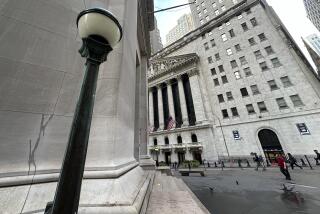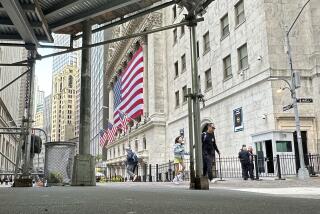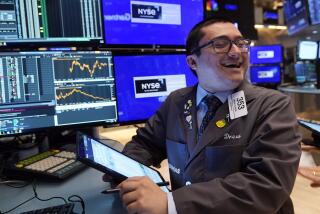IBM’s Blues May Benefit Its Tech Rivals
Technology stocks, one of the market’s hottest sectors since late summer, turned in another powerful rally on Thursday--a reminder not to let International Business Machines’ woes obscure the tech field’s vibrancy.
In fact, some Wall Streeters believe that the tech rally could get a boost should investors continue to sell IBM stock and invest the proceeds in more promising tech stocks.
Thursday’s rally was led by semiconductor titan Intel Corp., which leaped $3 to an all-time high of $86.50. Other big gainers included Apple Computer, up $1.875 to $56.875; computer networker Cabletron Systems, up $3.625 to $76.125, and BMC Software, which soared $4 to $68.50.
Even IBM managed to bounce up $1.125 to $53. But Wall Street sees little hope of a sustained rally in the troubled giant’s shares, now off from $62.375 a week ago and $100.375 last summer.
Tech-stock analysts generally agree that some of the group’s big gains since September stem directly from a shift by big investors out of IBM and into better tech ideas.
IBM has been the core tech stock in many institutional portfolios for decades. So as those owners sell even a portion of their IBM stock, the assumption is that they’ll want to put the proceeds back into technology--probably in a mix of big IBM rivals, such as Intel, and in up-and-comers.
Indirectly, IBM’s decline boosts other tech issues as more investors come to realize that IBM’s losses have been other companies’ gains: Microsoft, in personal computer software; Apple, in PC hardware, and Cabletron, Novell and Cisco Systems in tying different computers together.
However, with many tech stocks up 20% to 60% since September, some investors warn there may not be much more money to make in the short run.
Michael Di Carlo, manager of the John Hancock Special Equities stock fund in Boston, notes that tech stocks tend to follow a seasonal pattern--rallying in fall and winter, falling in spring and bottoming in summer. The pattern coincides with the computer industry’s sales cycle.
But as more investors have come to recognize the cycle, buying has begun earlier each fall--and the selling has started before spring. “It used to be you bought them at Halloween and sold them at St. Patrick’s Day,” Di Carlo says. Given the strength of this year’s rally, he says, a better target for the market peak might be Valentine’s Day.
Investors’ flight from IBM could help other tech stocks, but some analysts believe that the beneficiaries will mostly be the handful of other very large tech stocks--such as Intel, Motorola and Hewlett-Packard--rather than the bulk of smaller names. The reason: Big investors work with such large sums of money that they are virtually forced to play highly liquid stocks, for safety’s sake.
What’s more, Michael Murphy, editor of the California Technology Stock Letter in Half Moon Bay, Calif., says a lot of the money leaving IBM now is “yield money”--meaning the owners held IBM largely for its dividend yield. With a dividend cut likely, those IBM sellers probably will reinvest in utility stocks and other high-yield stocks.
Even so, analysts note that the strongest argument in favor of a sustained tech-stock rally is that business is great, outside of IBM. Bruce Lupatkin, analyst at brokerage Hambrecht & Quist in San Francisco, expects unit sales of personal computers to be up 20% this quarter versus a year ago. That will boost fourth-quarter earnings for many computer parts suppliers, software firms and networkers, and could carry into first-quarter results because of large order backlogs.
Also arguing for the tech rally is that the stocks’ price-to-earnings multiples, based on 1993 earnings estimates, in most cases aren’t wildly above the P-E of the Standard & Poor’s 500 index. Yet the tech companies’ earnings should grow substantially faster than the S&P; companies’ next year. Ordinarily, stocks boasting rapid earnings growth deserve much higher P-Es, Di Carlo notes.
His favorite tech ideas now include Cisco Systems, which has been doubling earnings each year. “There’s no slowdown in their momentum,” Di Carlo says. Another idea: Creative Technology, a young company that makes audio/visual equipment to enhance IBM computers.
Murphy would stay with Apple, because of its dramatic new product rollout plans for 1993, and disk-drive maker Seagate, among others.
Dan Leonard, manager of the Financial-Invesco Technology stock mutual fund in Denver, likes Read-Rite, which makes recording heads for small-computer disk drives; Cirrus Logic, a maker of computer chips that let PCs perform more complex functions, and Computer Sciences, which supplies computer services cheaper and better than many companies can do themselves.
The Tech Rally Since September
How some high-tech stocks have surged in the rally that began in late summer, and the stocks’ prices relative to expected 1993 earnings:
Thurs. Gain from ’93 Stock/market close Sept. low P-E* AST Research (O) $20 5/8 +68% 12 Creative Tech. (O) 20 1/2 +58% 18 Cisco Systems (O) 72 3/8 +55% 31 Intel Corp. (O) 86 1/2 +50% 21 Seagate Tech (O) 19 1/4 +48% 6 Compaq Corp. (N) 44 3/4 +41% 19 Cirrus Logic (O) 36 1/4 +41% 18 Cabletron Sys. (N) 76 1/8 +33% 23 Apple Computer (O) 56 7/8 +30% 12 Read-Rite (O) 28 3/4 +24% 15 Microsoft (O) 90 +23% 29 Computer Scienc. (N) 77 5/8 +21% 14 Novell Inc. (O) 27 1/2 +10% 25 S&P; 500 index 435.43 +4% 17
* ’93 P-E is stock price divided by estimated earnings per share in calendar 1993 or company’s fiscal year ending between June 1993 and June 1994
Markets: O -- NASDAQ; N -- NYSE
Source: Zacks Investment Research (earnings estimates)






